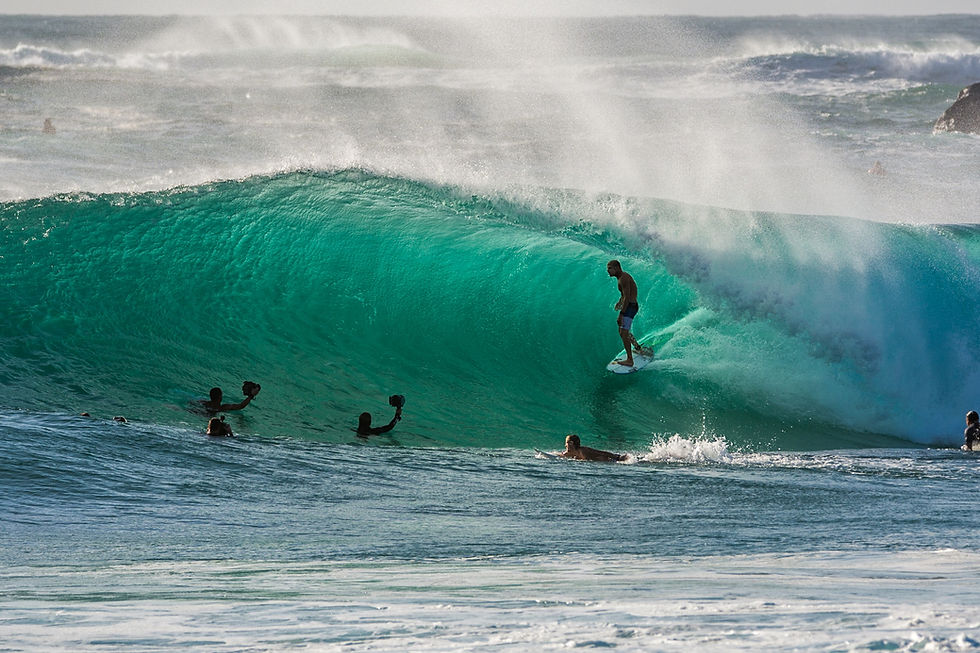Rocker 101: How Curve Dictates Speed and Control
- mcoe0911
- Oct 21
- 3 min read
When it comes to surfboard performance, few design features are as critical — or as misunderstood — as rocker. The rocker is the subtle curve from your board’s nose to tail, and it’s the secret ingredient that determines how your board paddles, turns, and holds speed. Whether you’re flying down the line or setting up a deep bottom turn, your board’s rocker profile plays a defining role in how it performs under your feet.
In this post we’ll break down what rocker is, how it works, and how entry, mid, and tail rocker each influence your board’s feel across different wave conditions.
What Is Surfboard Rocker?
The rocker refers to the curve of your surfboard’s bottom from nose to tail when viewed from the side. Some boards have a flat rocker that hugs the water for maximum speed, while others have a more pronounced curve that helps with control and maneuverability.
The key to finding your perfect ride is understanding the balance — too little rocker and you’ll pearl or lose control in steeper waves; too much rocker and you’ll sacrifice speed on smaller, weaker surf.
Entry Rocker: Paddling and Takeoff Control
The entry rocker is the curvature in the nose section of your surfboard. A flatter entry rocker makes it easier to paddle and catch waves, allowing the board to plane across the surface with less drag. That’s why beginner and small-wave boards tend to have a gentle nose curve. Conversely, a steeper entry rocker helps prevent nose-diving (“pearling”) when dropping into steep waves. It also allows for tighter turns in critical sections of the face.
Best for:
Flatter entry: Small, mushy waves and beginners.
Steeper entry: Hollow, powerful waves and advanced surfers.
Mid Rocker: The Balance Point
The mid rocker is the central curve that connects your nose and tail. This is where your board’s overall flow and speed are determined. A flatter midsection increases surface contact with the water, maximizing speed and glide — great for point breaks or long, drawn-out lines. A curvier mid rocker shortens the board’s turning radius, improving maneuverability for aggressive surfing styles.
Best for:
Flatter mid rocker: Long, rolling waves (think Malibu or Noosa).
More curve: Tight, pockety waves where responsiveness matters.
Tail Rocker: Turning and Hold
The tail rocker governs how your board releases water during turns. A flatter tail rocker boosts down-the-line speed, making it ideal for fast sections and small surf. On the other hand, a steeper tail rocker enhances pivot and control in steep, critical waves — but it demands more from the surfer.
Best for:
Flatter tail: Small to medium surf, cruisy style.
Steeper tail: Steep, barreling waves, vertical surfing.
Finding the Right Rocker for You
The magic lies in matching rocker to conditions and ability. If you surf mellow beach breaks, go for a flatter rocker for extra glide and easier paddling. If you chase powerful reef or point waves, a more pronounced rocker will help you stay in control and fit into the wave’s curve.
Many modern surfboards now feature blended rocker designs, optimizing paddling power up front and maneuverability out back.
A surfboard’s rocker defines its personality — fast and drivey, or loose and responsive. Understanding how entry, mid, and tail curvature interact helps you make smarter board choices for your local waves and style.
At Thyrasurf.com, we break down surfboard designs from every major brand so you can compare rocker profiles, tail shapes, and rail contours all in one place — helping you find the perfect board for the way you surf. SEARCH ALL BOARDS >


Comments